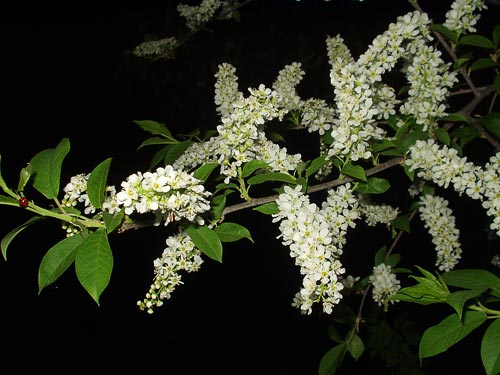Crops
Padus racemosa (Lam.)Gilib. - European bird cherry.
Taxonomic position.
Family Rosaceae Juss., genus Padus Hill.Synonyms.
Padus avium Mill., Prunus padus L., Padus asiatica Kom.Biology and morphology.
2n=32. Small tree up to 5-15 m tall or high shrub with a wideobovate crone. Leaves 3-10 cm length, 2-6 cm width, elliptic or broadly obovate with short point and acute-serrate margin, denudate or pubescence, on short leafstalks; wrinkled, matt upper leaf surface, glaucous lower leaf surface. Stipules awl-shaped, early fall away. Flowers white, fragrant, up to 2 cm diameter, on long pedicels, collected in friable, drooping racemes, up to 10-15 cm length. Flowering from April till June (depending on longitude, height above sea level, and weather condition). Fruit - juicy, black, shining, globe-shaped berry 7-8 mm diameter, sweet, astringent. Ripen in June - September. Stone spherical-ovate, pitted-striated or glabrate. There are several ornamental forms: weeping (f. pendula); many-color-leaved (f. variegata); double (f. plena); pinkflowered (f. roseiflora); yellow-fruited (f. leucocarpa); yellowish-green-fruited (f. chlorocarpa). Sorts: Mavra, Pamiati Salamatova, Plotnokistnaja, Pozdnjaja radost., Sakhalinskaja chernaja, Chernyi blesk. Species are noted for high polymorphism.Distribution.
Euroasiatic species. Has wide natural distribution. Grows from Kola peninsula on the west till Sea of Okhotsk on the east; till 64 degree of northern latitude in Siberia; grows everywhere on the south except for Middle Asia, Kazakhstan and Transcaucasia.Ecology.
Mesophyte. Frost-resisting. Requiring to soil and prefer deep, comparative rich and damp soils (alluvial, soddy-gley, soddy-podsolic); rather semi-shade. Very plastic and undemanding plant. Sustainable in urban condition.Economic value.
Flowers: honey.Fruits: food source (for kissel, drink, liqueur, filling for pie).
Bark: dyeing matters.
Wood: turning.s makes.
Plant: high decorative properties.
Almost all parts of plant have medicinal properties (astringent, germicidal, etc.), bactericidal, fungicidal and insecticidal properties.
The literature.
Atlas of areas and resources of officinal plants of the USSR. Ed. by P.S. Chikov, Moscow: GUGK, 1983, p. 325Trees and shrubs of the USSR. Ed. by S.Y. Sokolova. Vol. III. Moscow-Leningrad, 1954
Selivanova-Gorodkova E.A. Bird cherry and its biological features //Botanical Journal. 1957, vol. 42, N 8, p. 1258
Malakhovets P.M., Tisova V.A. Ornamental trees and shrubs on the North. Arkhangelsk, 2002. 128 p.
Vitkovsky V.L. Fruit Plants of the World. St. Petersburg-Moscow-Krasnodar. Lan'. 2003. 592 p.


